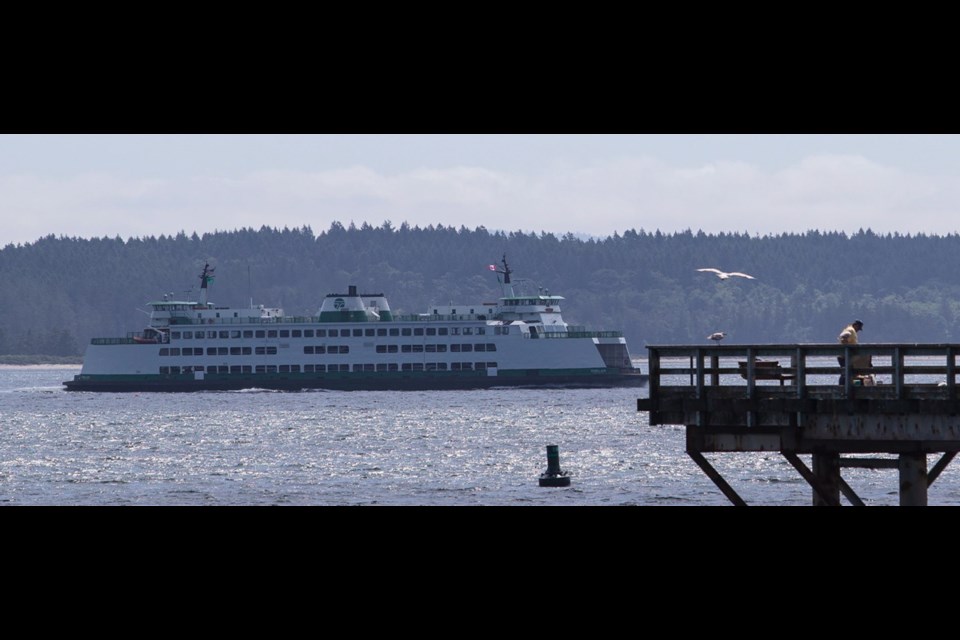To understand the problem facing the Sidney-Anacortes ferry run, think of the MV Elwha as the backup goaltender.
The creaky old Elwha is supposed to be the one that gets hauled off the bench and pressed into service when the starter, the MV Chelan, is injured — when it has a mechanical problem, say, or gets the line of a crab trap wrapped around a propeller.
The trouble is that the Elwha itself is on the injured list, probably permanently, and there’s no emergency backup like David Ayres in the wings, no ferry equivalent of a Zamboni driver waiting to strap on the pads and save the day. Washington’s state-owned ferry system doesn’t have another boat to fill the gap if both the 124-car Chelan and 144-car Elwha are sidelined at the same time.
In fact, Washington State Ferries did have to pull the plug on the Sidney-Anacortes service for four weeks in November when the only two vessels certified for the international route both ended up on the shelf.
Also, with the Elwha in the shop last summer and the fleet short of ships, there were occasions when the Chelan was diverted for domestic use, causing the Sidney run to be cancelled.
With the Elwha unlikely to ever return, are more cancellations inevitable after the Sidney service, currently on its usual three-month winter hiatus, resumes March 29?
It’s a troubling question for the tourist industry — and also a lesson in what happens when politicians allow a ferry fleet to rust. A lesson that our neighbours in Washington and Alaska are learning the hard way.
For many years, the state ferry systems and B.C. Ferries were all in the same, er, boat, competing with schools, hospitals and other capital projects for government funding. They usually lost. Building new ferries for the coast isn’t a sexy seller at election time in Kelowna or Prince George. Aging vessels weren’t replaced — except when the pendulum swung the other way and the province, injecting politics into an engineering decision, blundered into the fast-ferry fiasco of the late 1990s.
That changed for B.C. Ferries when Gordon Campbell’s Liberals sort-of privatized the fleet in 2003. Since then, semi-free to plot its own course, the corporation has embarked on an extensive (and expensive) replacement program, launching 14 new vessels, with five more on order.
The Washington system, by contrast, continues to be pushed around by political tides — and it always seems to be the Sidney service that’s in danger of hitting the rocks.
In 1977 and again in 1997, it took a big effort by officials in both Sidney and Anacortes to keep the run afloat. In 1999, Washington State Ferries was thrown into crisis by a statewide voter initiative to cut an automobile tax that provided the ferry system with much of its funding.
That last kerfuffle eventually led to funding cuts, which led to fare increases averaging 67 per cent over seven or eight years, which led to a drop in ridership. The Sidney-Anacortes ferry recorded the steepest decline of any route, losing 16 per cent of its ridership between 2000 and 2007 (the decision to halt service for three months each winter contributed to that).
The run came under threat again in 2008 during a government-ordered review of the cash-strapped, aging Washington fleet. Again the route survived, though challenges remained.
By 2009, with the economy in meltdown and on-again, off-again post-9/11 passport requirements for cross-border ferry travel finally implemented, ridership on the route linking Sidney to Anacortes and the San Juans bottomed out at 116,163. It had been 166,004 in 2002.
By 2019, ridership was back up to 135,661. Even with the unscheduled four-week gap caused by the loss of both the Chelan and Elwha, that was up from 2018.
The state government has no plans to end the service.
The state is also funding the construction of more ferries. The problem is that it is playing catch-up. “We’re probably two to three years away from seeing a new vessel,” says Ian Sterling, spokesman for Washington State Ferries. Even when that hybrid diesel-electric boat arrives, it doesn’t look like it will be added to the Sidney run.
Compounding the problem, the state ferry system must contend with the fallout of another voter initiative, one that would slash car-registration fees to $30. If upheld by the courts, that measure, passed last year, would gut transportation funding. Faced with that possibility, Gov. Jay Inslee’s yet-to-be-finalized budget does not include money for the maintenance work that would extend the life of the 53-year-old Elwha.
That brings us back to the backup goalie problem. The Chelan will be on its own when the century-old Sidney-Anacortes service (it runs once a day in the spring, twice in summer) resumes at the end of March. With rust showing through its white-on-green livery, the 39-year-old Chelan isn’t a spring chicken, either.
At least Washington doesn’t have to deal with the crisis that has hobbled Alaska’s ferry system this winter. First, a 30 per cent budget reduction driven by Alaska’s new governor resulted in service being cut to many of the remote places for which the boats are a lifeline. (The Anchorage Daily News reported this week that some coastal communities are running short of food.)
Then, in January, the only ferry still serving the mainline routes — the ones ranging from the Alaska panhandle to Prince Rupert and Bellingham, Washington — broke down.
In fact, just one of the Alaska Marine Highway System’s 12 vessels, the smallest, is still operating. “All others are offline either for lack of operating funds or because of mechanical problems,” the Anchorage newspaper reported Thursday.



